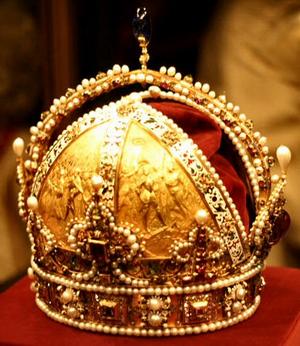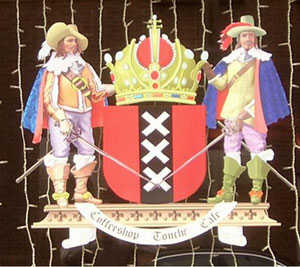 The official seal of Amsterdam shows a little ship (a kogge or cog) with two knights and a dog. According to a medieval story, the two men were caught by a storm, prayed to be saved, and decided to stay on the place where they landed. The three banners you see show a second heraldic symbol: this is the emblem of the lords of Aemstel, the noblemen who were responsible for the country along the river Amstel.
The official seal of Amsterdam shows a little ship (a kogge or cog) with two knights and a dog. According to a medieval story, the two men were caught by a storm, prayed to be saved, and decided to stay on the place where they landed. The three banners you see show a second heraldic symbol: this is the emblem of the lords of Aemstel, the noblemen who were responsible for the country along the river Amstel.
Once, they had been servants (ministeriales) of the bishop of Utrecht, but they attempted to become independent, were forced into vassalage by the count of Holland, and were ultimately expelled to Brabant, where the family lives to the present day. On this seal, the shield of the white knight has the weapon of Holland.
Although the castle of the lords of Amstel was a little upstream, at Ouderkerk, they cared about the town at the mouth of the river as well. Before 1275, they built a dam, which is commemorated in the name of the city: Amsterdam does -as you already suspected- indeed mean “dam in the Amstel”. The city still uses the three crosses of the Van Aemstel family. This is the office of the Old West Municipal District.
 The third symbol is the imperial crown, shown here. The crown was awarded to Amsterdam in 1488, because the Habsburg crown prince, Maximilian, had been healed from an illness after visiting the Holy Chapel of Amsterdam. When Maximilian became emperor in 1508, the princely crown was immediately replaced by the imperial one. Sometimes, Amsterdammers say that they are living “under the emperor’s crown”, but the expression is unfortunately becoming obsolete.
The third symbol is the imperial crown, shown here. The crown was awarded to Amsterdam in 1488, because the Habsburg crown prince, Maximilian, had been healed from an illness after visiting the Holy Chapel of Amsterdam. When Maximilian became emperor in 1508, the princely crown was immediately replaced by the imperial one. Sometimes, Amsterdammers say that they are living “under the emperor’s crown”, but the expression is unfortunately becoming obsolete.
The imperial crown on the Westerkerk is actually not the correct one. It is the Rudolphian crown, named after the emperor Rudolph II (1576-1612), and now in the Schatzkammer in the Hofburg in Vienna. The real crown of Maximilian was less pointy and was surrounded by fleur-de-lys. The sculptor who made this part of a bridge has tried to combine both crowns. The monument also includes the crosses of the Van Aemstels and the abbreviation SPQA, Senatus Populusque Amstelodamensis, Neo-Latin for Council and People of Amsterdam. This bridge was built in the 1930’s, too early for the final element to be added: the motto, Heldhaftig – Vastberaden – Barmhartig, ‘Heroic, Resolute, Compassionate’. 
Those words were added after the Second World War, during which the Amsterdammers had surprised the German occupiers by a big strike to prevent the deportation of the Jews. It was violently suppressed, and in spite of all heroism, resolution, and compassion, most Jews were taken away and killed. (Anne Frank is only one of them.) Many elder Amsterdammers feel a bit ashamed of the motto, beautiful words not backed up by sufficient deeds, and the owner of this pub replaced the device with the name of his establishment.
© Jona Lendering for
Livius.Org, 2006
Revision: 29 Dec. 2007






























